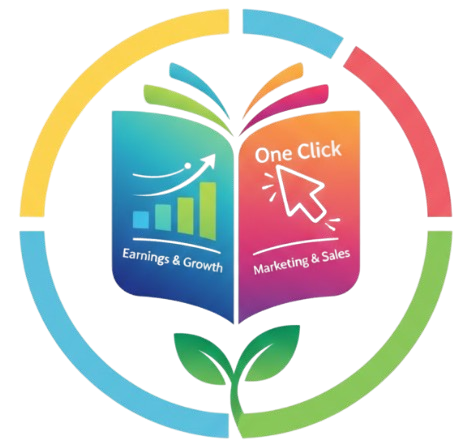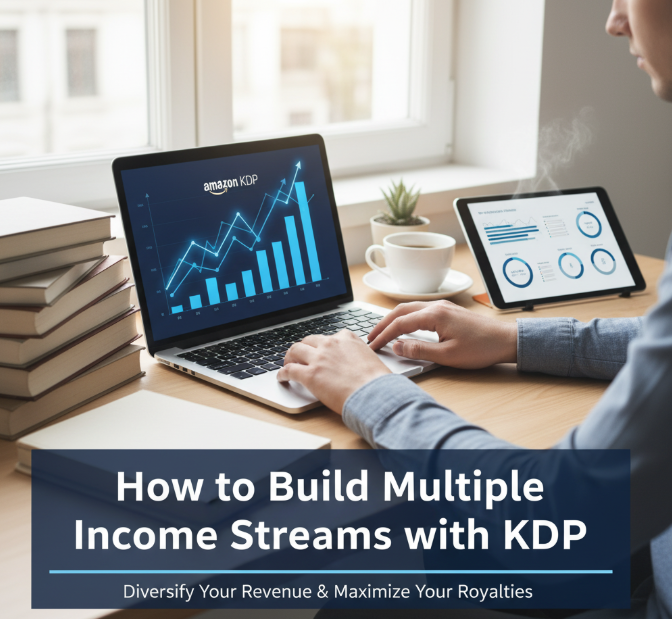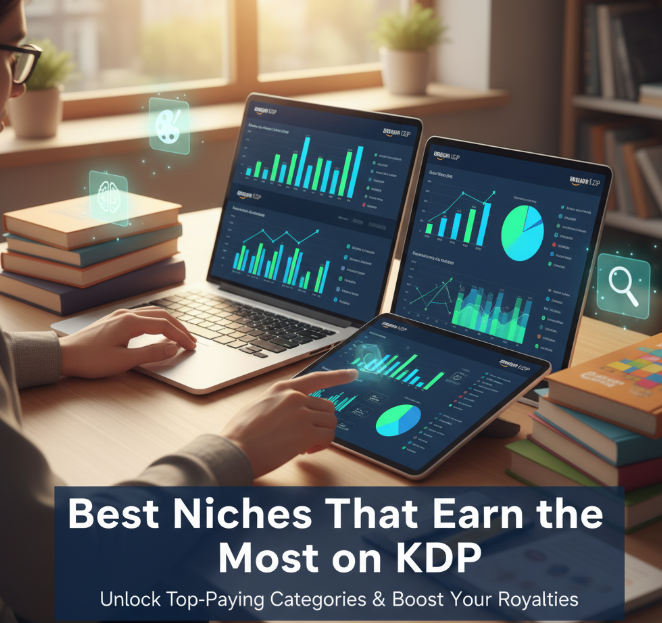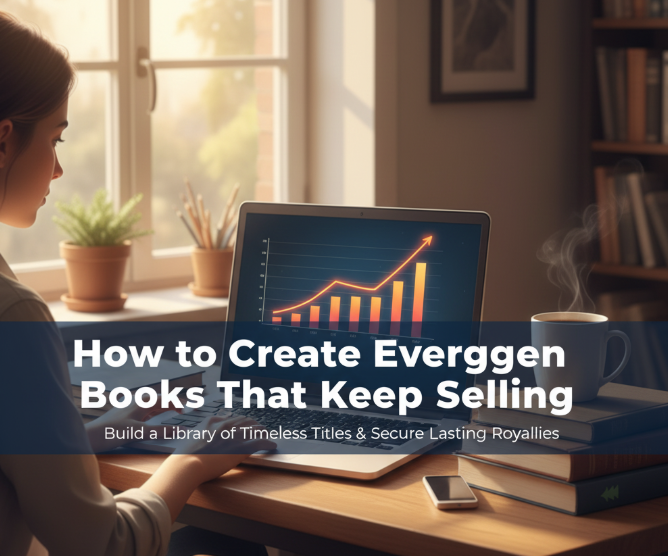It’s an effortless way to make money if you know the secrets, and Amazon’s Kindle Direct Publishing (KDP) platform will let you in on these secrets. Whether you’re a writer, artist or anyone searching for extra income, KDP provides several opportunities to make money without a big budget or extensive network. The best part? You can diversify creating all streams of income from one place.
This guide will take you through the process of building different streams of income on KDP. You will discover actionable tips real people are using to make a few hundreds to several thousand dollars a month. Let’s explore the world of self-publishing to see how you can get your ideas into a profit.
Why KDP is Great for Income Streams
Amazon KDP is not about publishing a book and crossing your fingers. It’s a full-on ecosystem where you can produce many different types of things, connect with millions of customers and make money in myriad ways. Here’s why it works so well:
Free to Begin: No upfront payment required. Amazon takes care of printing, shipping and customer service. You make money only when someone buys your book.
Huge Traffic: Amazon receives millions of page views each day. Your books can be found by readers all over the world without having to pay for advertising.
It Supports Multiple Types: Not just novels. You can publish and list paperbacks, hardcovers, eBooks, and even low-content books like journals and planners.
Passive Revenue Potential: After publishing a book, it can continue to sell for several years with minimal effort on your part.
Income Stream #1: Publishing eBooks
eBooks are the bread and butter of any KDP revenue plan. They’re relatively easy to publish, cost nothing to produce and can start selling a day or two after going live.
Finding Profitable Niches
The secret to eBook success is going after the right topic. You need something people are searching for and seeking, but not so hyper-competitive that it’s impossible to rank. Here are some winning niches:
- Self-help and personal development
- How-to guides and tutorials
- Recipe and cooking books
- Fiction genre bestsellers (romance, thriller and fantasy)
- Business and entrepreneurship
- Health and fitness guides
Pro Tip: Leverage Amazon’s Best Sellers Rank (BSR) to identify hot categories. Books in the BSR range of 100,000 or so are selling well. And if you see several books on the same subject performing well, then you’ve hit upon a lucrative niche.
Creating Quality Content
Basically, you got three options for getting eBook content:
Write It Yourself: This is free but time-consuming. It’s your best bet if you love writing or are a topic expert.
Hire Ghostwriters: You can find writers on platforms like Upwork or Fiverr who will write a post for $50–$500, depending on the length and quality.
Mine Your Public Domain Content: Books published before 1928 are in the public domain and you’re free to republish the text. You can excerpt new introductions, formatting – or even pair works together to create something entirely different.
Pricing Strategy for Maximum Profit
Your eBook price will determine your sales and your royalties. Here’s how it works:
| Price Tier | Royalty Rate | Ideal For |
|---|---|---|
| $0.99 – $2.98 | 35% | New authors building readership |
| $2.99 – $9.99 | 70% | Most books, best for discoverability and royalties per sale |
| $10+ | 35% | Premium content, textbooks |
Most of the successful publishers I work with price their eBooks somewhere between $2.99 and $4.99. Then look at the 70 percent royalty. And if it is at a sale price of $3.99 ($2.79) — and variants in between less than and above these numbers. Sell 10 books a day and that’s now $837 a month from one title.
Income Stream #2: Print-on-Demand Paperbacks
Softcover books don’t fetch as much per sale as eBooks do, but some readers just like paper. And by providing both, you increase your chances of closing a sale by two.
Why Paperbacks Matter
There are some people who just won’t ever purchase an eBook. They want a book to hold in their hands, write notes in the margins or set it on their shelf. By having paperback editions, you cover all of this market.
Profit Example: A $12.99 200-page paperback runs about $4 to print. You retain $8.99 less Amazon’s fees, around $3-4 per sale. Paired with eBook sales, that’s $5-7 per reader for one book.
Design Considerations
Paperbacks do not just want a properly formatted cover. If your book doesn’t look professional, readers won’t purchase. Here’s what you need:
- A professional cover ($50-200 if you hire someone)
- Interior formatting with proper margins
- ISBN (Amazon provides free ISBNs)
- Quality content
Cheap Book Cover Designing: Many publishers use Fiverr or 99Designs for less expensive cover design. A good cover can multiple your sales by ten, twenty times, making the investment worth it.
Income Stream #3: Low-Content Books
This is the part where KDP becomes really exciting. Low-content books are products that are low— or no-content, think journals, planners, coloring books and notebooks.
Top-Selling Low-Content Categories
There is a vast and burgeoning world of low-content space. Here are the hottest categories:
Planners and Organizers
- Daily planners
- Budget trackers
- Meal planning journals
- Fitness logs
Notebooks and Journals
- Lined journals
- Dot grid notebooks
- Gratitude journals
- Travel journals
Activity Books
- Adult and children’s coloring books
- Puzzle books (sudoku, word search)
- Drawing books
- Comic book templates
Creating Low-Content Books Fast
One thing that makes low-content books appealing, of course, is speed. You can create and post one in a day. Here’s the process:
- Select Your Niche: Examine best sellers to see where there are deficiencies/opportunities
- Design the Inside: You can use Canva, PowerPoint or specific programs like Book Bolt
- Design a Cover: It needs to be attention grabbing and professional
- Submit To KDP: Enter information, how much to charge, submit
- Repeat: Successful publishers have 50 to 500 titles
Income Potential: A low-content book might not sell more than 1-5 copies per day, but if you have a hundred of them, the sales start to add up. If you sold 100 books at the same $2 profit per book and only 2 sales a day per book, then that’s earning you over $12,000 each month!
Seasonal Opportunities
Smart publishers produce low-content books—seasonal type:
- Christmas planners (publish in September)
- Back-to-school organizers (publish in June)
- New Year’s diaries (release November)
- Summer activity books (publish March)
These seasonal surges can make peak months a real financial bonanza for you.
-
💰 Discover more: Understanding KDP Royalties and Payment System
Income Stream #4: Hardcover Books
Hardcover publishing has recently been added as a service to KDP by Amazon. Hardcovers are more prestigious and carry a premium price.
When to Publish Hardcovers
Hardcover isn’t for every book. Best candidates include:
- Coffee table books
- Premium gift books
- Special editions of popular titles
- Photography or art books
- Comprehensive guides and textbooks
Hardcovers are more expensive to print, but they sell for $20–40, and you get better margins. A book that makes $4 in net profit as a paperback might bring in $10-12 as a hardcover.
The Gift Market Advantage
Hardcovers sell especially well around holidays since people want to give nice gifts. A gorgeously designed cookbook or inspirational book in hardcover simply seems more valuable than a paperback.
Income Stream #5: Series and Bundles
Single books are awesome, but series and boxed sets increase your revenue per customer.
Creating Book Series
The problem is, once readers fall in love with your debut novel, they want more. The trilogy or cycle keeps them purchasing:
- Fiction series (3-7 books typical)
- How-to series covering related topics
- Cookbook series by diet or cuisine
- Series of children’s books with repeated characters
Strategy: Price the first book down a notch ($0.99-$2.99) to reel readers in, then charge full price for sequels. If 100 people buy book one and 60% go on to books 2 and 3, now you’re earning three times as much from these customers.
Bundle Strategy
And then after you release individual books you can offer bundles:
- Three book bundles priced at 20 percent off individual prices
- Complete series collections
- Themed bundles (all of your cookbooks or all of your journals)
Bundles raise average order value and can get you ranked across several categories.
Income Stream #6: Kindle Unlimited (KU) Royalties
Kindle Unlimited is Amazon’s subscription service that allows readers to pay monthly and get unlimited access to books on the list. You make money by enrolling in KU, per page read.
How KU Payment Works
Amazon shares from a global fund and the divide is based on all KU books read by you. Prices fluctuate between months, but the average is between $0.004-0.005 per page.
Example: If a 200 page book is read in full, it makes around $0.80-1.00. If 100 readers complete your book in a given month, then you’re looking at $80-100 in KU revenue, plus whatever sales you have from non-KU readers.
The Good and Bad of Going to KU
Advantages:
- Enjoy the bonus revenue from page reads
- Better visibility in Amazon’s algorithm
- Access to promotional tools through KDP Select
Disadvantages:
- Can’t be sold on other platforms—must be exclusive to Amazon
- Earnings fluctuate monthly
- Earnings per reader less than full book sales
A lot of successful publishers tend to sign up for 90 days in KU and then decide if performance is good enough to stay exclusive or go wide.
Income Stream #7: Translations and Overseas Markets
English-language publishing is only the start. Amazon does business in many countries, and translated books open up entirely new markets.
Most Profitable Languages
Here are the highlights where the highest return can be achieved:
- Spanish (big market, not too expensive to translate)
- German (high purchasing power)
- French (established reading culture)
- Italian (growing market)
- Portuguese (Brazil is massive for books)
Translation Cost: A professional translator charges $0.03-0.10 per word. It costs $600-2,000 to have a book that’s 20,000 words translated — but you can recoup this money in three to six months if you play on the hot topics.
Publishing on International Amazon Sites
You can publish the same book at:
- Amazon.com (US)
- Amazon.co.uk (UK)
- Amazon.de (Germany)
- Amazon.fr (France)
- Amazon.es (Spain)
- Amazon.it (Italy)
- Amazon.ca (Canada)
Each marketplace is separate income. A book making $300 a month in the US could make an additional $100-200 from both UK and EU combined.

Income Stream #8: Audiobook Scale Up With ACX
KDP books can be made into audiobooks via ACX (Audiobook Creation Exchange), Amazon’s audiobook marketplace.
The Audiobook Opportunity
Audiobooks are booming. People listen in the car, at the gym, while doing chores. You can use your books that you already have for this format.
Production Options:
- Narrate Yourself: Free, but good quality recording equipment is necessary
- Hire a Narrator: ACX makes finding the right professional safe and easy
- Royalty Share: Narrator doesn’t get paid upfront, you both make 50% each on sales
Income Potential
Audiobooks typically sell for $10-25. Under ACX’s 40% royalty option, a $15 audiobook pays you $6 for each sale. Because audiobook listeners are a different market than readers, this is pure extra income and does not eat into book sales.
Building a Publishing Business: Do the Math
Here are some very realistic revenue projections depending on your publishing approach:
Beginner Strategy (3 Months)
- 10 low-content books
- 2 eBooks with paperback versions
- Minimal marketing
Estimated Monthly Income: $200-500
Intermediate Strategy (6-12 Months)
- 50 low-content books
- 10 eBook/paperback combinations
- Some books in Kindle Unlimited
- Basic keyword optimization
Estimated Monthly Income: $1,000-3,000
Advanced Strategy (12-24 Months)
- 100+ low-content books
- 25+ eBook/paperback/hardcover titles
- Series and bundles
- Translated editions
- Active marketing and email list
Estimated Monthly Income: $3,000-10,000+
Marketing Your KDP Books
The publication of books is just half the battle. You need customers to discover and purchase them.
Amazon SEO Optimization
Amazon is a search engine. When a customer searches for “meal planner” or “weight loss guide,” you want your book to pop up. Optimize these elements:
Title: Include main keywords naturally
- Bad: “My Amazing Planner”
- Good: “Meal Planning Journal: 52-Week Food Planner with Grocery Lists and Recipe Pages”
Subtitle: Include secondary keywords and benefits
7 Keywords: Use all seven backend keyword slots Amazon offers
Categories: Select the most appropriate categories where you will have a better chance to rank
Social Media and Content Marketing
Build an audience outside Amazon:
- Pinterest for visual books (cookbooks, planners, journals)
- Instagram for lifestyle content
- YouTube for reviews and updates from authors
- Facebook groups in your niche
- TikTok for viral book marketing
It’s not that you need millions of people following you. A few hundred loyal fans who believe in your recommendations can create consistent sales.
Amazon Advertising
When your books are proven sellers, re-invest your profits into Amazon ads. Start with $5-10 budgets per day and see how it goes:
- Sponsored Product ads in search results
- Target competitor book pages
- Bid on keywords related to your topic
When starting your ACoS (Advertising Cost of Sales) you should be looking at between 50-70% ultimately working it down.
Books that convert well can then afford more ad spend, greatly increasing your income.
Avoiding Common KDP Mistakes
Don’t let other’s mistakes cost you time and money.
Mistake #1: Poor Research
Do not publish random books and hope they will sell. Research demand first:
- Check Best Seller Ranks
- Read reviews of customers to know what people need
- Identify gaps in existing offerings
Mistake #2: Low-Quality Covers
Your cover is your book’s billboard. An amateur cover will kill sales (fine content or no). Spend $50-100 on professional design or teach yourself design.
Mistake #3: Quitting Too Early
Most successful KDP publishers didn’t make money with their first book. They learned from the experience, revised their methods and published more. Some have gone through 30 books before they finally hit on a real winner.
Mistake #4: Ignoring Trademarks
Always avoid brand names, character names and copyrighted properties of any kind. Disney, Marvel and other rightsholders actively search for infringements. Keep to original material or stuff you develop yourself.
Mistake #5: No Marketing Plan
It’s getting much harder to just publish and hope for organic sales. Before release, have a basic business plan. Learn more about effective book marketing strategies.
Tools That Make Publishing Easier
Savvy publishers work faster and smarter with tools:
Research Tools
- Helium 10 (keyword research)
- Publisher Rocket (niche analysis)
- KDP Spy (competitor analysis)
Creation Tools
- Canva (covers and interiors)
- Book Bolt (low-content templates)
- Vellum (eBook formatting)
- Creative Fabrica (graphics and fonts)
Organization Tools
- Trello or Asana (project management)
- Google Sheets (to keep tracking of sales and expenses, etc.)
- Buffer or Hootsuite (social media scheduling)
Free trials or free versions are available with most tools. Begin with the free offerings and increase only when your income supports it.
Scaling Your KDP Income
As soon as you’re earning consistent money, these are the tricks that can help you grow:
Outsource Repetitive Tasks
Your time is valuable. Hire as you generate profit:
- Cover design
- Interior formatting
- Ghostwriting
- Research
- Customer service
Focus on new projects.
Expand Product Lines
Don’t stay in a niche forever. Successful publishers grow into related categories over time, diversifying risk and finding new profitable opportunities.
Build an Email List
Collecting reader emails lets you:
- Notify new releases to those who are ensured buyers
- Build relationships with fans
- Launch books with initial sales (to get a ranking)
- Promote other products or services
You can also offer a freebie in exchange for email signups on the back of your books.
Create Premium Offerings
Once established, add higher-priced products:
- Comprehensive courses
- Coaching or consulting
- Premium print editions
- Exclusive bundles
Your readers of your book are a very warm audience that already trusts you, so they’re more likely to convert into higher ticket offers.

Frequently Asked Questions on How to Earn Money By Using KDP
Q: How much does it cost to start my career with KDP?
A: Technically zero. You can write, format and publish books yourself for free. Practically $100-300 allows you to have professional quality covers and possibly some tools that will lead to better results faster.
Q: How soon will I make my first sale?
A: This varies wildly. Some people make a sale within 24 hours of posting, others wait weeks. On average, it can take 7-30 days to make your first sales if you have done well with the research and optimization.
Q: Can I actually earn over $1,000/month?
A: Yes, but it takes work. Most people making $1,000+ a month have 20 or more books published and spent 6-12 months building their catalog. It can absolutely be done but not instantly.
Q: Do I have to be a good writer?
A: Not necessarily. A lot of the successful KDP publishers either outsource or do low-content books that don’t require much writing. For some income streams, design and business savvy matter more than writing skills.
Q: Is KDP saturated? Is it too late to start?
A: Competition is fiercer, but Amazon’s customer base keeps getting bigger. Books are sold by the millions every day. There is still huge potential for new publishers, with good research and quality products.
Q: How many books do I need to sell to make a good income?
A: There’s no magic number. Some publishers are making $3,000 a month on 10 really good books. Others require 100+ low-content books to reach the same income level. The more books the better, usually. But quality is just as important as quantity.
Q: I don’t live in the US, can I publish books?
A: Yes! KDP is available in most countries around the world. You may need to get tax set up right, but KDP is used by publishers in India, UK, Canada, Philippines, etc. It’s used in dozens of countries.
Q: What if I get a bad fact or two into my book?
A: You can update books at any time. Correct mistakes, upload fresh files and Amazon will send out the new version. Current buyers don’t receive automatic updates, however new purchases are delivered with the corrected version.
Your Action Plan: How to Do It
Excited to create your KDP income streams? Here’s your step-by-step plan:
Week 1: Research and Learning
- Read through the best-sellers in 3-5 categories that you’re interested in
- Watch videos on YouTube with tutorials on how to publish in KDP
- Join KDP Facebook groups
- Create your KDP account
Week 2: Creating Your First Product
- Your best point of entry is likely a low-content book
- Create or outsource the content
- Be sure to have a professional cover
- Write compelling book description
Week 3: Publish and Optimize
- Upload your book to KDP
- Set competitive pricing
- Choose the right categories and keywords
- Publish and wait for approval (24-72 hours)
Week 4: Launch and Learn
- Post on social media about your book
- Get good, honest reviews from family and friends
- Track sales and rankings
- Start working on book #2
Month 2-3: Build Momentum
- Publish 2-3 more books
- Test different niches and formats
- Experiment with pricing
- Learn what works for you
Month 4-6: Scale Up
- Accelerate publishing schedule
- Use profits to purchase better covers or tools
- Start building series or bundles
- Consider translations or audiobooks
Final Words: Your Journey in Publishing Begins Now
Creating multiple income streams with KDP is not a way to get-rich-quick. It’s a proper business, one that rewards consistency, quality and smart strategy. The publishers making real money didn’t just luck out— they studied the system, published consistently and kept honing their skills.
The wonderful thing about KDP is that it’s democratic. You don’t need contacts, a degree or special permission. All you need is a willingness to learn and work. Your first book might flop. Your tenth might too. But at some point on your journey as a publisher, you’ll discover that perfect balance — the one that lands you steady income each month.
Every single successful KDP publisher began where you are now – zero books published, and wondering if it would even work. The divide between the people who are getting paid and those who gave up is simple: persistence.
Your income streams remain to be created. The only question is: will you make the first move today?
Begin small, learn quickly, publish frequently and watch your revenue streams grow. Welcome to the world of KDP publishing — your future fortune awaits.




